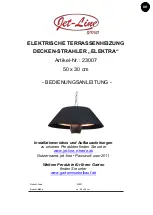
GP-MSJV-BX-07A
STV-JZ Manual
RD: MAR 2009
RL: 07A - BA
11. FLUE VENTING
T
HIS
STV-JZ
SERIES
IS
APPROVED
FOR
BOTH
DIRECT
AND
INDIRECT
VENTING
APPLI-
CATIONS
. T
HE
SYSTEM
MUST
NOT
BE
OPERATED
WITHIN
A
NEGATIVE
AIR
CONDITION
,
UNLESS
COMBUSTION
AIR
IS
BROUGHT
IN
FROM
OUTSIDE
DIRECTLY
TO
THE
BURNER
.
I
F
NEGATIVE
PRESSURE
IS
EXPERIENCED
OR
ANTICIPATED
IN
THE
HEATED
SPACE
,
THE
SECOND
PORT
(
BARB
)
ON
THE
BLOCKED
FLUE
SWITCH
SHOULD
BE
CONNECTED
DI-
RECTLY
TO
OUTSIDE
AIR
USING
1/4”
PLASTIC
HOSE
FROM
BLOCKED
FLUE
SWITCH
TO
OUTSIDE
OF
BUILDING
(
NOT
SUPPLIED
).
Page 16
INDIRECT VENTED APPLICATION
DIRECT VENTED APPLICATION
A length of ‘C’ Vent is to be installed on the
swaged end of the last tube before any Tee or El-
bow is fitted. When the heater is installed and in-
directly vented, it is required in Canada that the
heater be electrically interlocked to an independ-
ent exhaust fan by means of an Air Proving
Switch. The exhaust fan must be sized to create
3CFM for every 1000 Btu/hr or fraction thereof,
of total input of installed equipment. Consult
CSA.B149.1-00 latest edition for requirements.
In the USA when a heater is installed unvented
the system requires consideration of normal infil-
tration and introduction of outside air by natural
or mechanical means, and/or electrically inter-
locked to an independent exhaust fan. Consult
your local codes and ANSI Z223.1 latest edition.
for all venting requirements, and practices.
All venting must be single wall 4” diameter 26
gauge minimum vent except that portion of vent
passing through a combustible wall or roof then
type “B” vent may be used as per CSA’s interim
requirement. When venting horizontally, the flue
vent system must slope downwards approxi-
mately 1/4" per foot toward the vent terminal,
starting at the termination of the radiant tube.
For horizontal through the wall venting, the ap-
proved 4" (JA-0528-XX) or 6" (JA-0529-XX) hori-
zontal wall vent terminal or a high-wind termina-
tion cap approved by a nationally recognized cer-
tification agency can be used and mounted 18"
from the outside wall to the inside edge of termi-
nal opening to alleviate back pressure caused by
turbulent wind conditions (See Fig. 17). This will
also ensure flue gases are directed away from
the structure to protect building materials from
degradation by the exhausted flue gases. It is the
sole responsibility of the installer to be familiar
with current local codes or ANSI Z223.1 /
CSA.B149.1-00 latest editions for all venting re-
quirements, and practices.
For vertical through the roof venting, use a ‘B-
vent’ termination cap as supplied by the manufac-
turer of the approved ‘B-vent’.
















































